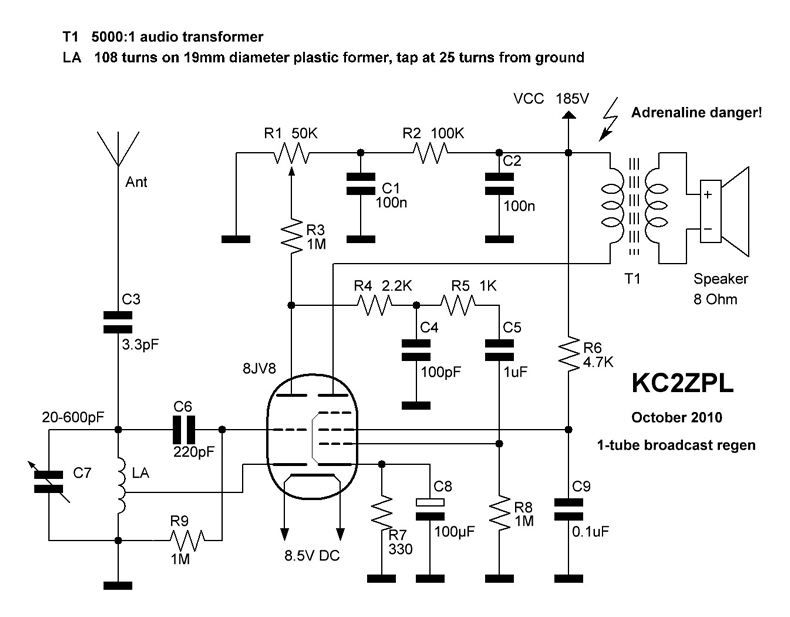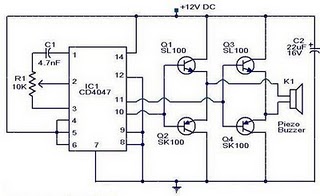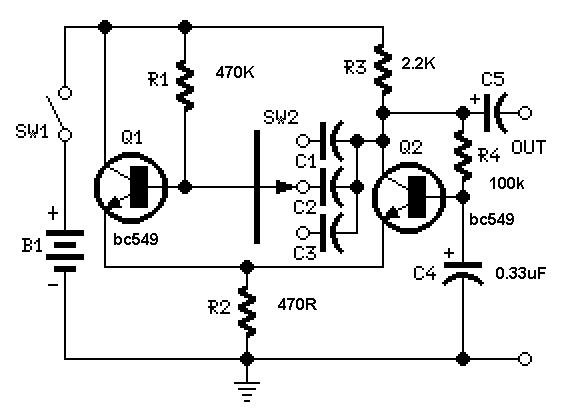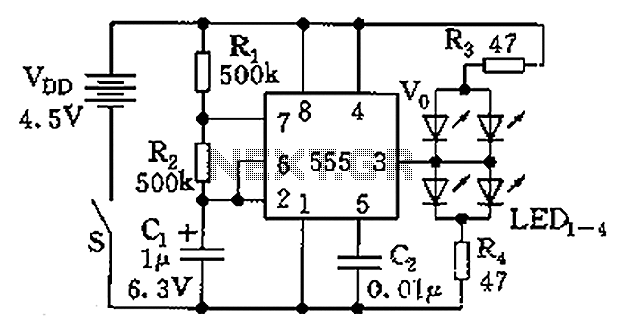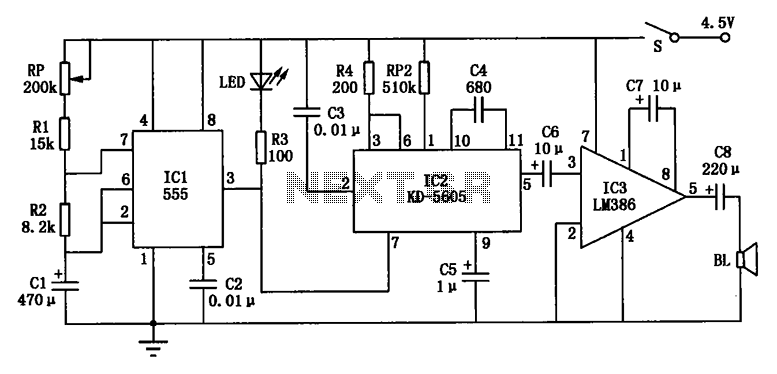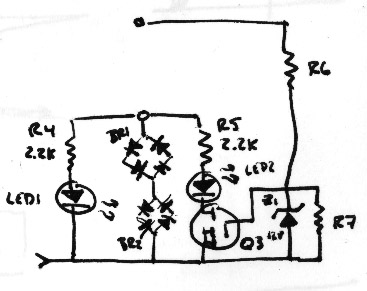
Electronic Die
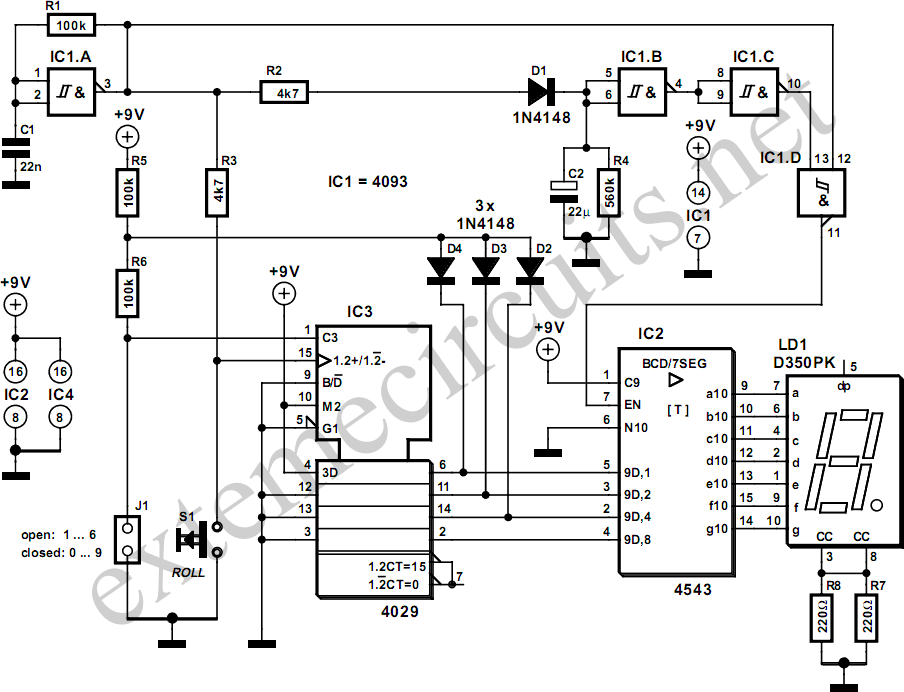
The simplicity of a traditional die makes it exceptionally difficult to create a fully equivalent electronic version, primarily because an electronic version necessitates a power supply and a collection of electronic components that occupy a significantly larger volume than a conventional die. This article describes an electronic die that can be constructed using standard components or surface-mount devices (SMDs) as preferred, and which closely resembles the format of a traditional die when using SMDs. Despite its straightforward design, this electronic die incorporates several interesting features. For example, the range of spots can be expanded from 1-6 to 0-9 using a jumper, and it has a standby function that disables the display approximately 8 seconds after the die is thrown, in order to conserve energy. The electronic die also operates efficiently by driving the display in pulsed mode. Consequently, the current consumption of the circuit is approximately 25 mA during operation and 12 mA in standby mode, allowing it to be powered easily by a 9-V battery. The circuit is composed of several components: a free-running oscillator (IC1a), additional logic for driving the display (IC1c & IC1d), a timer (IC1b), a counter (IC3), and a display decoder (IC2). The oscillator is quite simple, with a frequency determined by R1 and C1, approximately 225 Hz, and a duty cycle of around 50-60 percent. The signal from the oscillator serves as a clock signal for the counter (via R2) and a blanking signal for the display decoder (via IC1d). However, the counter does not count while the throw switch (S1) is closed, as the clock input of IC3 is grounded by S1. The blanking input of the display decoder is driven by a pulse waveform, resulting in the display being illuminated only about 50 percent of the time, although it appears continuously lit due to the high clock frequency. The standby mode functions as follows: as long as there is a signal on the clock input of the counter (when S1 is pressed), the output of gate IC1b remains low, keeping the display enabled. When S1 is released, the counter halts, and a number is displayed. The clock pulses will have charged C2 via D1, which will slowly discharge through R4. After approximately 8 seconds, the output of gate IC1b will go high, causing the display to turn off. The counter design is relatively straightforward. It is configured as an up-counter by connecting the U/D pin to VCC. The preset inputs (pins 4, 12, 13, and 3) are set to binary 0001, and the counter typically has a counting range of 0-9 (with pin 9 connected to ground). Diodes D2, D3, and D4, along with resistor R5, function as a logic AND gate; if the counter value exceeds 6, the preset value of 1 is latched into the counter, allowing it to reset and count from 1 to 6. This occurs only when jumper J1 is open. If J1 is closed, the preset pulse on PREN is suppressed, and the counter range remains 0-9. The A, B, C, and D inputs of the decoder IC (IC2) are driven directly by the counter. Instead of placing series resistors for the individual segments of the display, these are located in the common-cathode lead (R7 & R8). This design choice reduces the number of required resistors, although it can lead to variations in display brightness depending on the number shown. If the segment current is sufficiently high, saturation occurs, and brightness variation becomes negligible. The Blank input (BL) controls the display's enable function. When constructing this circuit using SMD technology, the schematic diagram remains unchanged, but component selection will differ. In this scenario, SMD components must be utilized for the resistors and C1, while diodes should be replaced with BAS32 types, and BT versions of ICs IC1 and IC3 should be used instead of conventional types. An SMD version of C2 was not implemented in the prototype due to the high cost of SMD electrolytic capacitors, which are typically sold in lots of 10, similar to other passive components. It is also advisable to utilize a socket for the SMD version of the display to maximize space under the display and further minimize the circuit board dimensions. Any desired DC power source providing a voltage between 5 and 15 V can serve as the power supply. Given the circuit's low current consumption, a 9-V battery can provide a long operational life.
The electronic die circuit is designed to mimic the functionality and appearance of a traditional die while integrating modern electronic components for enhanced features. The core of the circuit is the oscillator (IC1a), which generates a clock signal that drives the counter (IC3) and controls the display's pulsing behavior. The use of a jumper to switch the counting range from 1-6 to 0-9 provides flexibility in operation, allowing the user to customize the die's behavior.
The standby function is particularly noteworthy, as it conserves battery life by disabling the display after a brief period of inactivity. This is achieved through a combination of capacitive charging and discharging, which ensures that the display is only active when needed. The use of a common-cathode configuration for the display segments simplifies the circuit and reduces component count, although care must be taken to manage brightness consistency across different displayed values.
In summary, this electronic die circuit combines simplicity with functionality, providing an engaging alternative to traditional dice. Its design allows for easy assembly using either standard or SMD components, making it accessible to a wide range of builders and hobbyists. The thoughtful integration of features such as adjustable counting range, energy-efficient display operation, and standby mode enhance the usability and longevity of the device, making it a practical addition to any electronic project.The simplicity of a traditional die makes it exceptionally difficult to create a fully equivalent electronic version, if only because an electronic version requires a power supply and a collection of electronic components that occupy a much larger volume than a normal die. This article describes an electronic die that can be built using normal com ponents or SMDs as desired, and which comes very close to having the same format as a traditional die in the latter case. Despite its simplicity, this electronic die incorporates several interesting features. For instance, the range of spots` can be increased from 1 6 to 0 9 using a jumper, and it has standby function that disables the display approximately 8 seconds after the die has been thrown`, in order to save energy.
The electronic die also uses energy efficiently by driving the display in pulsed mode. As a result of the latter two features, the current consumption of the circuit is approximately 25 mA in use and 12 mA in standby. This means that it can easily be powered by a 9-V battery. The circuit consists of the following parts: a free-running oscillator (IC1a), additional logic for driving the display (IC1c & IC1d), a timer (IC1b), a counter (IC3) and a display decoder (IC2).
The oscillator is very simple. Its frequency, which is determined by R1 and C1, is approximately 225 Hz, with a duty cycle of around 50 60 percent. The signal from the oscillator acts as a clock signal for the counter (via R2) and a blanking signal for the display decoder (via IC1d).
However, the counter will not count as long as the throw` switch (S1) remains closed, since the clock input of IC3 is grounded by S1. The blanking input of the display decoder is driven by a pulse waveform, so the display is in principle illuminated only around 50 percent of the time, but it appears to be constantly illuminated due to the high clock frequency.
The standby mode works as follows. As long as there is a signal on the clock input of the counter (S1 pressed), the output of gate IC1b is low and the display is enabled. If S1 is released, the counter stops and a number will be shown on the display. However, the clock pulses will have charged C2 via D1, and C2 will slowly discharge via R4. After approximately 8 seconds, the output of gate IC1b will go high, causing the display to be blanked.
The design of the counter is relatively simple. It is wired as an up counter by connecting the U/D pin to VCC. The preset inputs (pins 4, 12, 13 and 3) are configured to binary 0001`, and the counter normally has a counting range of 0 9 (pin 9 connected to ground). Diodes D2, D3 and D4, in combination with resistor R5, act as a logic AND gate, so if the value of the counter is greater than 6, the preset value of 1 is latched into the counter and it starts to count again from 1 to 6.
This only happens if jumper J1 is open. If it is closed, the preset pulse on PREN is suppressed and the counter range is 0 9. The A, B, C and D inputs of the decoder IC (IC2) are driven directly by the counter. The series resistors normally used for the individual segments of the display are instead placed in the common-cathode lead (R7 & R8). This has the advantage of allowing the number of resistors to be reduced, although it has the drawback that the brightness of the display depends on the displayed number.
If the segment current is sufficiently large, (light) saturation occurs and this brightness variation is no longer noticeable. The Blank input (BL) controls whether the display is enabled. If you choose to build this circuit using SMD technology, that will not affect the schematic diagram, but it will naturally affect the choice of components.
In this case, SMD components must be used for the resistors and C1, the diodes must be replaced by BAS32 types, and BT versions of ICs IC1 IC3 must be used instead of conventional types. An SMD version of C2 was not used in the prototype, since SMD electrolytic capacitors are expensive, and normally they are only sold in lots of 10, just like other passive components.
It is also recommended to use a socket for the display of the SMD version of the electronic die, to allow the space under the display to also be used and the dimensions of the circuit board to be further reduced. Any desired DC power source providing a voltage of 5 to 15 V can be used as a power supply. Due to the low current consumption of the circuit, a 9-V battery will last quite a long time. 🔗 External reference
The electronic die circuit is designed to mimic the functionality and appearance of a traditional die while integrating modern electronic components for enhanced features. The core of the circuit is the oscillator (IC1a), which generates a clock signal that drives the counter (IC3) and controls the display's pulsing behavior. The use of a jumper to switch the counting range from 1-6 to 0-9 provides flexibility in operation, allowing the user to customize the die's behavior.
The standby function is particularly noteworthy, as it conserves battery life by disabling the display after a brief period of inactivity. This is achieved through a combination of capacitive charging and discharging, which ensures that the display is only active when needed. The use of a common-cathode configuration for the display segments simplifies the circuit and reduces component count, although care must be taken to manage brightness consistency across different displayed values.
In summary, this electronic die circuit combines simplicity with functionality, providing an engaging alternative to traditional dice. Its design allows for easy assembly using either standard or SMD components, making it accessible to a wide range of builders and hobbyists. The thoughtful integration of features such as adjustable counting range, energy-efficient display operation, and standby mode enhance the usability and longevity of the device, making it a practical addition to any electronic project.The simplicity of a traditional die makes it exceptionally difficult to create a fully equivalent electronic version, if only because an electronic version requires a power supply and a collection of electronic components that occupy a much larger volume than a normal die. This article describes an electronic die that can be built using normal com ponents or SMDs as desired, and which comes very close to having the same format as a traditional die in the latter case. Despite its simplicity, this electronic die incorporates several interesting features. For instance, the range of spots` can be increased from 1 6 to 0 9 using a jumper, and it has standby function that disables the display approximately 8 seconds after the die has been thrown`, in order to save energy.
The electronic die also uses energy efficiently by driving the display in pulsed mode. As a result of the latter two features, the current consumption of the circuit is approximately 25 mA in use and 12 mA in standby. This means that it can easily be powered by a 9-V battery. The circuit consists of the following parts: a free-running oscillator (IC1a), additional logic for driving the display (IC1c & IC1d), a timer (IC1b), a counter (IC3) and a display decoder (IC2).
The oscillator is very simple. Its frequency, which is determined by R1 and C1, is approximately 225 Hz, with a duty cycle of around 50 60 percent. The signal from the oscillator acts as a clock signal for the counter (via R2) and a blanking signal for the display decoder (via IC1d).
However, the counter will not count as long as the throw` switch (S1) remains closed, since the clock input of IC3 is grounded by S1. The blanking input of the display decoder is driven by a pulse waveform, so the display is in principle illuminated only around 50 percent of the time, but it appears to be constantly illuminated due to the high clock frequency.
The standby mode works as follows. As long as there is a signal on the clock input of the counter (S1 pressed), the output of gate IC1b is low and the display is enabled. If S1 is released, the counter stops and a number will be shown on the display. However, the clock pulses will have charged C2 via D1, and C2 will slowly discharge via R4. After approximately 8 seconds, the output of gate IC1b will go high, causing the display to be blanked.
The design of the counter is relatively simple. It is wired as an up counter by connecting the U/D pin to VCC. The preset inputs (pins 4, 12, 13 and 3) are configured to binary 0001`, and the counter normally has a counting range of 0 9 (pin 9 connected to ground). Diodes D2, D3 and D4, in combination with resistor R5, act as a logic AND gate, so if the value of the counter is greater than 6, the preset value of 1 is latched into the counter and it starts to count again from 1 to 6.
This only happens if jumper J1 is open. If it is closed, the preset pulse on PREN is suppressed and the counter range is 0 9. The A, B, C and D inputs of the decoder IC (IC2) are driven directly by the counter. The series resistors normally used for the individual segments of the display are instead placed in the common-cathode lead (R7 & R8). This has the advantage of allowing the number of resistors to be reduced, although it has the drawback that the brightness of the display depends on the displayed number.
If the segment current is sufficiently large, (light) saturation occurs and this brightness variation is no longer noticeable. The Blank input (BL) controls whether the display is enabled. If you choose to build this circuit using SMD technology, that will not affect the schematic diagram, but it will naturally affect the choice of components.
In this case, SMD components must be used for the resistors and C1, the diodes must be replaced by BAS32 types, and BT versions of ICs IC1 IC3 must be used instead of conventional types. An SMD version of C2 was not used in the prototype, since SMD electrolytic capacitors are expensive, and normally they are only sold in lots of 10, just like other passive components.
It is also recommended to use a socket for the display of the SMD version of the electronic die, to allow the space under the display to also be used and the dimensions of the circuit board to be further reduced. Any desired DC power source providing a voltage of 5 to 15 V can be used as a power supply. Due to the low current consumption of the circuit, a 9-V battery will last quite a long time. 🔗 External reference
